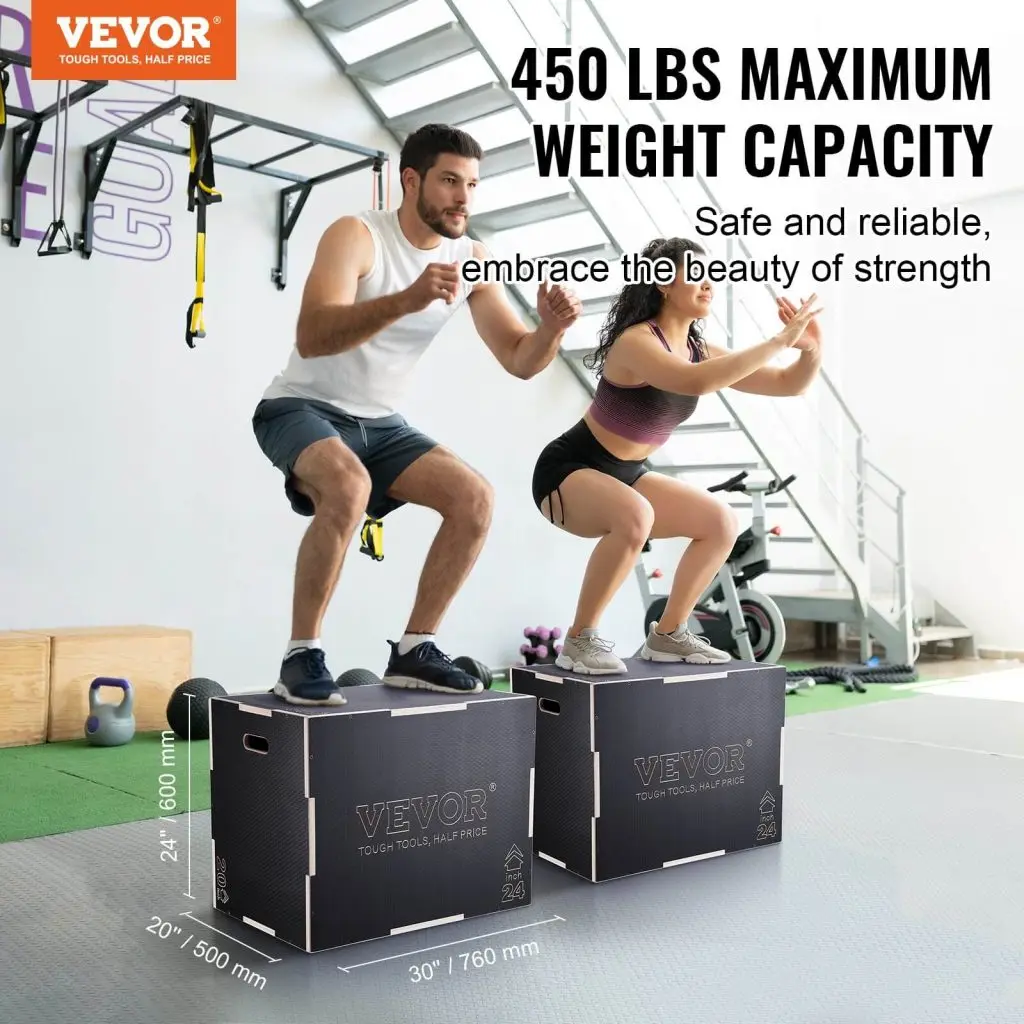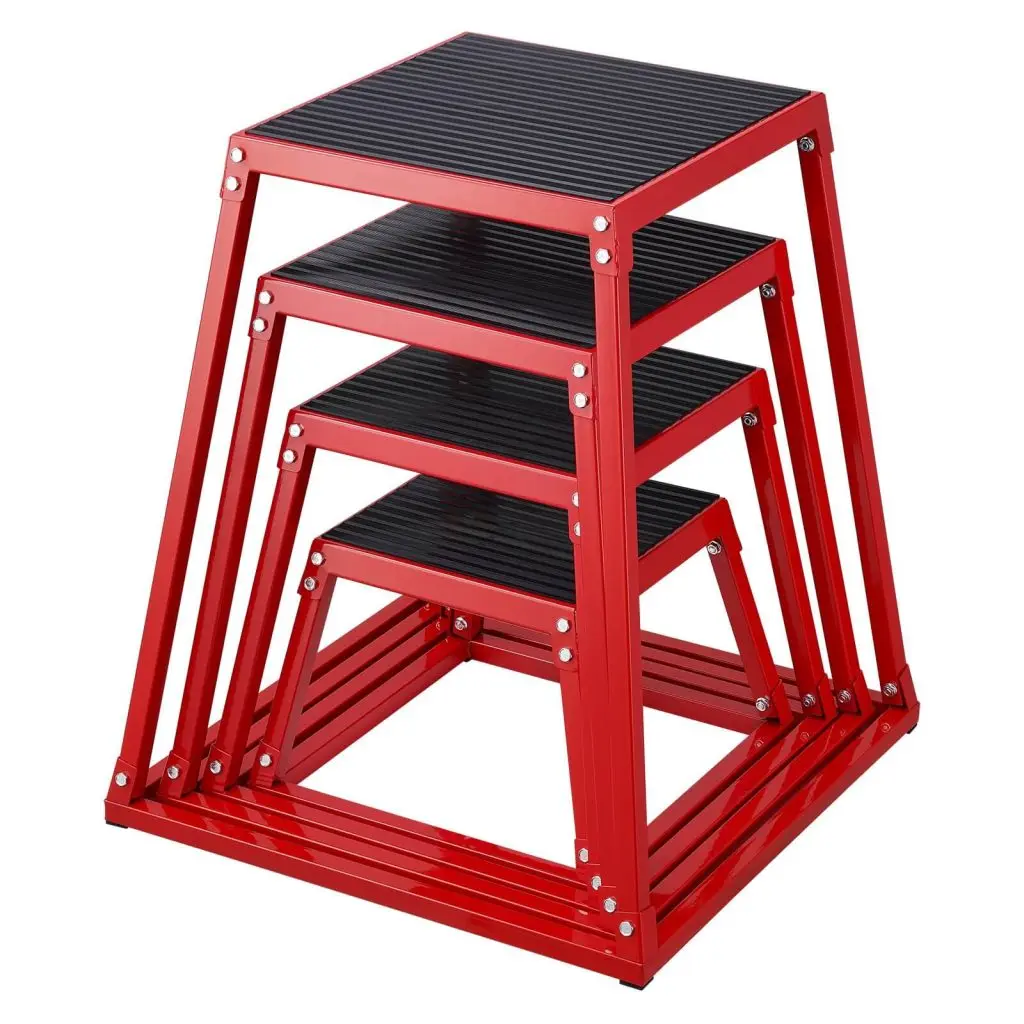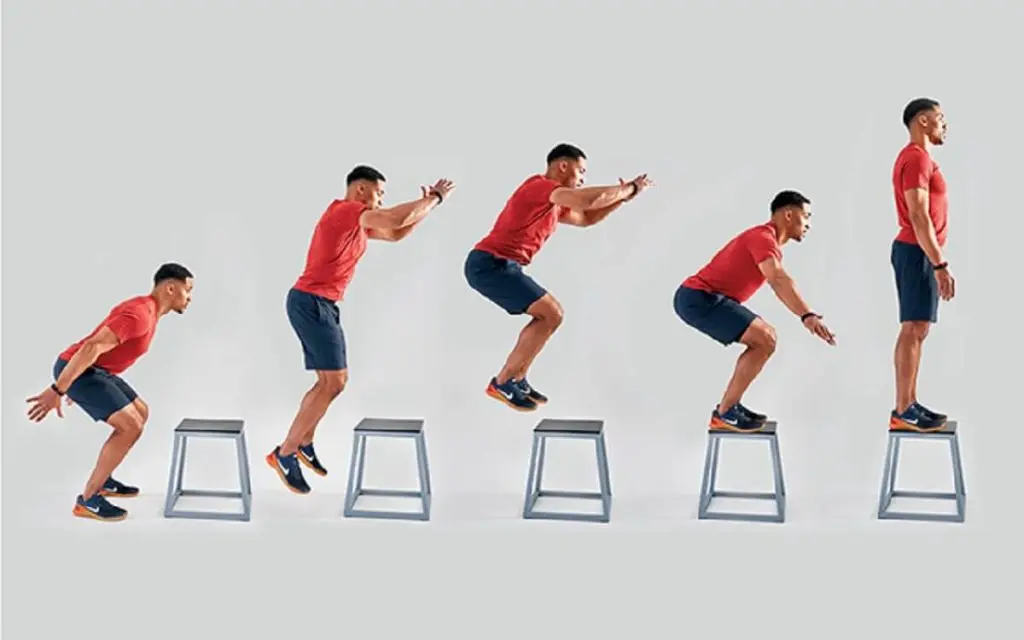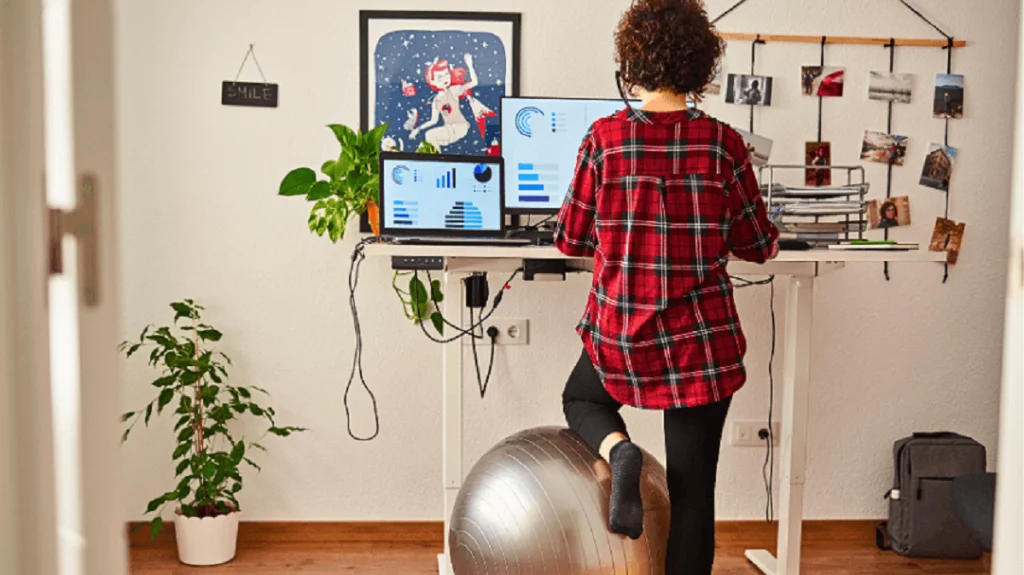Box jumps have become a mainstream feature in fitness routines all over the world. Whether you’re an athlete, a gym rat, or a home workout aficionado, this explosive movement offers myriads of benefits that can help you reach your fitness goals.
There are numerous jump boxes on the market, but we recommend the VEVOR Plyo Jump Box. The tool offers a safe and versatile platform to perform box jumps effectively. Box jumps benefits include improved cardiovascular health, muscular strength boost, as well as better coordination and balance.
In this article, we’ll examine these benefits and show you how you can achieve them using box jumps.
Table of contents
What Are Box Jumps?
Box jumps typically involve jumping explosively onto a raised platform, usually a plyometric box. Be warned, this routine looks deceptively simple at face value. It may seem even elementary, but don’t be deceived, for the devil is in the details.
From time to time, you may even find yourself wondering what these details are. The exercise works multiple muscle groups, which is one of the benefits of box jumps. It also increases your strength and speed, as well as tasks your coordination and power.
Basic Technique of Box Jumps
You can approach box jumps from two perspectives— either you focus on power or on conditioning.
One of the box jump benefits is explosiveness. If this is what you’re looking to work on, aim for 3-4 sets of 5 reps while taking several minutes rest in between sets. On the other hand, if endurance is your goal, you’ll need a lower box. Aim for 3 sets of up to 20 reps. Your rest time between each set can not be more than a minute.
As a beginner, it’s advisable to choose a box that’s on the shorter side until you get a better grasp of things:
Your height is also a factor. If you are up to about 5 foot 4 inches tall, you need a jump box that is about 14- or 16-inch tall. If you are 5 foot 9 inches or taller, your best bet is a 16- or 20-inch box. Here’s how to perform a basic box jump:
- Stand with your feet shoulder-width apart, facing the box.
- Engage your core and squat down slightly, swinging your arms back for momentum.
- Explode upwards, extending your hips and knees fully to jump onto the box.
- Land softly on the balls of your feet and maintain balance momentarily.
- Step down or jump down safely when finished.
Remember: You need proper form to prevent injuries. It is very important. Focus on a controlled landing and avoid arching your back during the jump.
The Benefits of Box Jumps
Box jumps offer you an all-inclusive workout routine that targets various aspects of your fitness. Here’s a breakdown of the primary box jump benefits:
Improves Cardiovascular Health
Box jumps are probably in the top range of the most explosive workout routines you’ll ever come across. And due to this explosiveness, it is only normal that box jumps can elevate your heart rate and improve cardiovascular endurance. This will in turn translate to better overall fitness and increased stamina for other activities.
Boosts Muscular Strength and Power
Box jump workouts aren’t about testing how quickly you can bend your legs after a jump, rather it’s to test how you lift your center of mass. What this means is, the higher your hips go, the more effective the workout is. As already established, it’s high impact workout, and typically targets these areas of your body:
- Glutes
- Quads
- Calves
- Hamstrings
- Core muscles
When working on these muscles, box jumps improve your power development and enable you to activate and contract them faster. And this you can do with higher force, which is very important.
Enhances Coordination and Balance
Jumping exercises, known in the gym as plyometric training, are fantastic when it comes to enhancing coordination and balance. This is because in order to pull off a perfect box jump, you need precise coordination for takeoff and landing. Doing this over and over again improves motor abilities and overall balance. It’s really great, especially for athletes.
What Do Box Jumps Help With?
One of the most important questions you can ask is what do box jumps help with? This is because you need to know what it does to know if it’s for you. Box jumps are versatile in what you can achieve with them. That’s why it’s as appealing to professional athletes as it is to the gym loving waiter who works in the restaurant down the road. Here are some fitness goals box jumps can help you with:
Weight Loss and Fat Burning
When walking you burn 200 to 300 calories per hour. Now imagine how many calories you can burn jumping at a very fast pace. With box jumps your body can burn close to 1,000 calories per hour. And this kind of jumping initiates changes in the mitochondria— which is where fuel is converted into energy, thereby helping you burn fat. It also builds muscles, which is another goal of many fitness enthusiasts.
Increased Agility and Speed
Box jumps being a dynamic kind of workout routine naturally improves your agility and reaction time. It improves your footwork, gives you quicker movements and generally boosts your athleticism. If you play basketball, surf, or skateboard professionally or in your spare time, then this is something you should look to incorporate into your workout routine.
Mental Toughness and Discipline
Box jobs are not just challenging, they require intense focus and determination. When you pick up box jumps as part of your workout routine, and you keep at it consistently over a period of time, it can build up your mental toughness and discipline. And as you know, these sorts of added value can spill over into other aspects of your life including your work and personal goals.
How to Incorporate Box Jumps into Your Workout Routine
There are few different ways with which you could incorporate box jumps into your workout routine. You could decide to start out with box jumps after your warm up, but not after strength training, in order to keep you fresh and mentally alert. Or, you could choose to do your box jobs in between your strength training sets. Also, completing box jumps sets after a set of squats can help maximize power and boost athletic performance.
Warm-Up and Safety Precautions
It is important to prepare your muscles and joints before you engage in box jumps. Always warm up by using a lower box height and only increasing it as you feel yourself gaining confidence and strength. Only use a stable box with a non-slip surface, like the VEVOR Plyometric Jump Box, to avoid falls and potential injuries.
Sample Box Jump Workout Routine
A typical box jump workout routine can differ from one individual to another, mostly depending on what you want to achieve. Regardless, here’s an example of a standard workout routine that includes box jumps:
- Warm-up: For five minutes, simply do some light cardio and dynamic stretches
- Box Jumps: Take on 3 sets of 10 repetitions. Most importantly, start with a low box height and gradually increase as you gain confidence.
- Rest for 30 seconds between each set.
- Cool-down for 5 minutes and perform static stretches.
Don’t forget to modify the number of sets, repetitions, and box height based on your height and fitness level. Also, if you’re just starting out, you can add box jumps to your workout once or twice a week. Giving yourself 2-3 days of rest in between will help your body recover properly.
Recommended For Your Project
Why Choose the VEVOR Plyo Jump Box?

The VEVOR 3-in-1 Plyometric Jump Box is a wooden, 30/24/20 inch box for plyometric training. Recycled cotton and foam are the other materials included in the makeup of this jump box. The VEVOR Plyo Jump Box is an excellent choice for performing box jumps effectively and safely. Here’s why:
Durable and Safe Design
The VEVOR Plyometric Jump Box is made of high quality wood and primed for durability. It has a non-slip surface that ensures safe landings and prevents injuries. Also, the box has a triple sided design that offers three different height options (30/24/20) for safety purposes.
Versatility and Adjustability
The VEVOR Plyo Jump Box’s triple-sided design is not just for safety, it is also to cater to various exercises and skill levels. If you’re a beginner, you can start with the lowest height and progress to higher levels as you gain strength and confidence. The box can also be used for other exercises such as step-ups, lunges, and dips, making it a multifunctional addition to any home gym.
Frequently Asked Questions about Box Jumps
These are some of the most frequently asked questions about Box Jumps.
Are Box Jumps Suitable for Beginners?
Absolutely! Box jumps can be a valuable addition to a beginner’s workout routine. It is however important to begin with a low box height, focus on proper form, and gradually increase the height as you become stronger. You should consult a trainer or coach for guidance, especially if you’re new to plyometric exercises.
How High Should My Box Be?
The ideal box jump really depends on your fitness levels. As a beginner, you might want to start with a box as low as 12 inches while experienced jumpers can go all the way to 36 inches. A good rule of thumb for choosing the right box is to look for the height that allows you to jump and land on the box comfortably with both feet.
Can Box Jumps Replace Cardio Workouts?

Whilst box jumps are a fantastic way to improve cardiovascular health, they may not necessarily replace dedicated cardio workouts. Truly, box jumps elevate your heart rate significantly, but if you incorporate other cardio exercises like running, swimming, or cycling into your routine, you could enjoy well-rounded cardio benefits.
What Are the Common Mistakes to Avoid?
Mistakes are normal when you’re new to something but the good thing about finding this article is that you don’t have to make them when you can avoid them. Here are some mistakes to avoid during box jumps.
- Landing on your heels: Doing this puts excessive stress on your joints. You should rather aim to land softly on the balls of your feet.
- Arching your back: It is super important to maintain a straight back throughout the jump to prevent injuries.
- Jumping with stiff legs: During the jump, bend your knees and hips for proper power generation and landing mechanics.
- Using excessive momentum: Use your leg strength to achieve a controlled jump, rather than relying solely on momentum.
Conclusion
What are the benefits of doing plyometrics? Well, box jumps exercises provide you with a wealth of benefits from boosting your cardiovascular health, strengthening your muscles, to enhancing coordination and athletic performance. They can be a valuable addition to your workout routine, regardless of your fitness level.
The VEVOR Plyo Jump Box, with its durable construction, non-slip surface, and adjustable height options, is what you need to perform safe and effective box jumps. Given all the box jumps benefits you’ve read about, you should consider incorporating box jumps into your exercise regimen, by purchasing the VEVOR Plyo Jump Box for optimal results.





